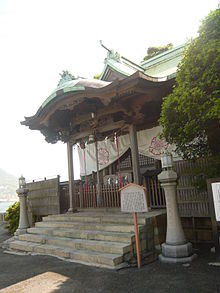You can help expand this article with text translated from the corresponding article in Japanese. (September 2011) Click for important translation instructions.
|
| Mekari-jinja 和布刈神社 | |
|---|---|
 The honden, or main shrine The honden, or main shrine | |
| Religion | |
| Affiliation | Shinto |
| Deity | Emperor Chūai Empress Jingū |
| Location | |
| Location | 3492, Moji, Moji-ku, Kitakyūshū Fukuoka 801-0855 |
 | |
| Geographic coordinates | 33°57′39″N 130°57′44″E / 33.96083°N 130.96222°E / 33.96083; 130.96222 |
| Architecture | |
| Date established | C.200 AD |
| Website | |
| mekarijinjya | |
Mekari Shrine (和布刈神社, Mekari-jinja) is a Shinto shrine located in Moji-ku, Kitakyūshū, Fukuoka, Japan.
History
The wife of Emperor Chūai, Empress Jingū, came here sometime during the legendary military invasion of Korea in the 3rd century. She had Mekari Shrine built as a way of giving thanks to the Kami. The present main shrine was rebuilt in 1767 by the Ogasawara clan from Harima.
Mekari Shinji Shinto ritual
In the shrine's Shinto ritual called Mekari Shinji, wakame seaweed is cut from the ocean at low tide and offered to an altar in a ceremony conducted in the early morning hours of the first day of the New Year according to the old lunar calendar. The ritual is thought to bring about good luck and has been designated an Intangible Folk Cultural Asset by Fukuoka prefecture.
See also
Gallery
-
View of Kanmon Straits from the shrine
-
A torii standing with Kanmonkyo Bridge in background
References
- "Mekari Shinji (Shinto Ritual)". Fukuoka Prefecture. Retrieved 17 September 2011.
External links
- Official website (in Japanese)
- Crossroad Fukuoka - Fukuoka Prefecture Tourist Information (in English)
| Shinto shrines | |||||||||||||||||||||||||||||
|---|---|---|---|---|---|---|---|---|---|---|---|---|---|---|---|---|---|---|---|---|---|---|---|---|---|---|---|---|---|
| |||||||||||||||||||||||||||||
| |||||||||||||||||||||||||||||
This article relating to Shinto is a stub. You can help Misplaced Pages by expanding it. |